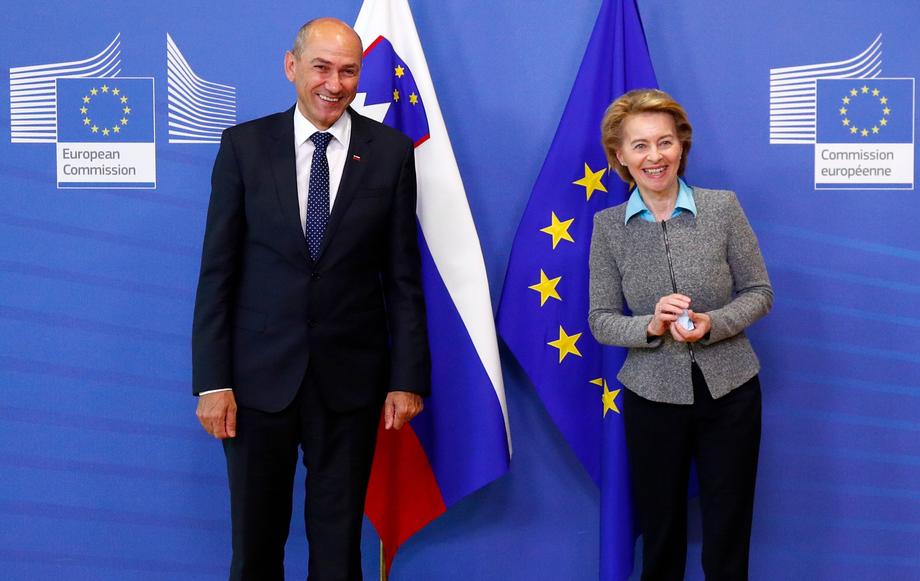The European Commission has raised its economic growth forecast for Slovenia from 0.8 percent to 1 percent, and from 1.7 percent to 2 percent for next year. Inflation is expected to reach 6.1 percent in 2023 and fall to 3.5 percent in 2024. “Slovenia’s GDP is projected to grow by 5.1 percent in 2022, mainly due to a strong carry-over from 2021,” they wrote in the forecast; however, the national media outlet’s MMC web portal failed to mention this in its article. “Probably because we had a different government at the time, which was obviously very successful in its work,” MEP Romana Tomc commented on the media’s omission of this fact.
Slovenia’s GDP is projected to grow by 5.1 percent in 2022, mainly due to a significant carry-over from 2021. In the first three quarters of 2022, private consumption continued to increase, and investments proved to be strong. Imports grew much faster than exports, resulting in a negative contribution from net exports. However, the economy contracted quite sharply in the third quarter. The slow improvement in economic sentiment in recent months suggests that this trend could partially reverse in the last quarter of the year. Employment remained high, and the industrial production indicators also improved, the report said.
Continued global economic uncertainty and tightening of financial conditions are expected to constrain growth in early 2023, but with employment remaining high and wage growth strong, economic growth is expected to improve from the second half of 2023, the European Commission’s report said. Private consumption is projected to pick up only modestly after a rapid increase in 2022, while investment is expected to continue to grow, partly supported by public investments, supported by the Recovery and Resilience Facility. Public consumption is projected to grow faster than in 2022, driven by an increase in public wages. Export growth is set to accelerate in 2023, but net exports are expected to remain negative on the back of strong imports. Overall, GDP is projected to expand by 1 percent in 2023 and 2 percent in 2024.
Inflation in the final quarter of 2022 was slightly lower than in the third quarter. However, energy inflation was the only component that decreased, with the prices of industrial goods, food and services increasing faster than before. Overall, inflation averaged 9.3 percent in 2022. With global energy prices easing and growth remaining weak, headline inflation is projected to decrease to 6.1 percent in 2023. In 2024, inflation is forecast to fall further to 3.5 percent, on the back of assumed economic growth and moderation of energy prices. Core inflation is expected to remain elevated on account of more generalised price and wage growth, the report also states.
“The forecast shows optimism, and it also shows that the European economy is much more resilient than was thought just a few months ago,” commented our Minister of Finance, Klemen Boštjančič, who also said that the forecast of slightly higher economic growth of 0.2 percentage points was not a big deal, as the fiscal challenges remained the same. In its winter assessment that was published last year, the European Commission lowered its expectations for Slovenia’s economic growth, while forecasting higher economic growth for 2023 and 2024. Last November, the Commission forecasted 6.2 percent, while the winter forecast is for gross domestic product to grow by 5.1 percent. The Statistical Office of the Republic of Slovenia (SURS) has also recently published data on economic growth in 2022: gross domestic product in the fourth quarter of 2022 is up 0.2 percent, it said, explaining that a further moderation in economic activity was detected in the fourth quarter. Compared to the fourth quarter of 2021, GDP increased by 0.2 percent. Domestic consumption had a positive impact on GDP growth, while exports had a negative impact. On a seasonally adjusted basis, GDP increased by 0.8 per cent compared to the third quarter of 2022.
In the fourth quarter of 2022, domestic consumption increased by 1.2 percent compared to the same period a year earlier. This was positively driven by household consumption and gross fixed capital formation. Household consumption increased by 2.6 percent, and gross fixed capital formation by 5.9 percent. The impact of the change in inventories on GDP growth was negative this time. Both exports (down by 2.5 percent) and imports (down by 1.5 percent) fell in the quarter under review, the first contraction in both since the fourth quarter of 2022. The contribution of the external trade surplus to GDP growth was negative by 0.9 percentage points. Value added increased by 1.4 percent, compared to the same period of the previous year. The main contributors to growth were construction and professional, scientific, technical and other business activities. The most pronounced decline in value added was recorded in the combined activities of mining, quarrying, manufacturing, electricity and water supply, which recorded a decline of 6.3 percent compared to the same period in 2021, which was the first decline in this activity in the last two years. Total employment was 1,083,800 persons, an increase of 1.6 percent or 16,700 persons on an annual basis. Most of the new employment was in construction and manufacturing. For the whole of 2022, GDP was 5.4 percent higher than in 2021. In the first half of 2022, growth in most components of GDP was more pronounced than in the second half of the year. Both final consumption and gross investment contributed positively to GDP growth, while the contribution of the external trade balance was negative. The external trade surplus narrowed to 961 million euros (previous year: 3,310 million euros), due to a faster increase in imports compared to exports and weaker terms of trade in all four quarters of 2022, the Statistical Office reports.
Sara Kovač


